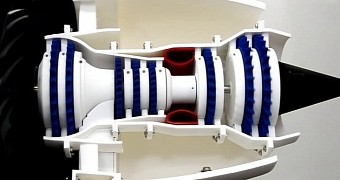Jets are huge things, and their components are only slightly less huge compared to the common man, and even the largest uncommon man, which is why it's not that easy to make those parts, and impossible to create them in one go.
3D printing may change all that though, except, perhaps, the whole “in one go” part of things. Although it should still reduce the number of different components significantly.
As it happens, companies from Japan are looking into this matter very enthusiastically. In fact, an outfit by the name of id.arts has 3D printed an entire two-axis rotary jet engine. Or at least a model of one.
Worldwide-known equipment manufacturer IHI Corporation set the order, as it wants to explore new ways of doing its job.
Since it specializes in industrial machines, ships, suspension bridges, aero-engines and car turbochargers, the model was right up its alley.
The 3D printed jet engine model
The Japanese company used selective laser sintering technology to make it, and even managed to do it in a very short time, specifically 9 days.
And of those, one day was dedicated to the design stage, and another to the creation of the 3D model. So you could say the huge jet engine was made in a week.
Selective laser sintering 3D printing technology works by melting powder together with a laser, then adding another powder layer and repeating the process, again and again.
SLS is used for metal printing, but the engine replica wasn't made from that. Instead, the majority of the body was designed from a nylon polyamide. Moreover, many of the parts besides the main body, like the pressure compressor, combustion chamber, cone nozzle, high pressure compressor and high pressure shaft, were 3D printer using normal FDM technology from ABS plastic.
As for the motor turning the turbines, it's a speed control motor provided by Oriental Motor. It's the only part that wasn't 3D printed, as far as we can see, and can be remotely controlled. Well, besides the bearing, pulley, low pressure shaft and the rest of the stainless steel mechanical system.
What the product will be used for
Exhibition and proof of concept, mostly. IHI Corporation might be persuaded by it to try actually building a genuine engine from metals and whatever else. While the contraption is composed of 105 different 3D printed parts (plus 440 bolts/screws/nuts and 30 mechanical components), they're still fewer in number than in engines assembled from parts made through traditional assembly lines. If not, id/arts can probably refine the print process with enough time.

 14 DAY TRIAL //
14 DAY TRIAL //